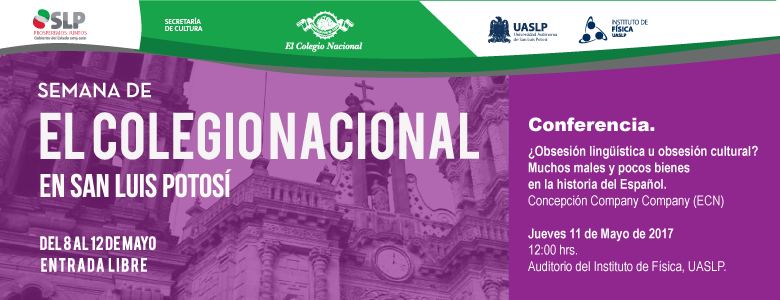Coloquio del Instituto de Física
El Coloquio del Instituto de Física se lleva acabo unicamente en vivo en nuestro canal de YouTube
Liga YouTube
https://www.youtube.com/channel/UCijcZAcDo1Ih5u9e8kiFP3g
Contacto e información: Ing. Cristina Cázares Grageda
Programación del Semestre Agosto - Diciembre 2022
|
|||
| Fecha | Ponente | Procedencia | Tema |
| 1 de febrero | |||
| 8 de febrero | |||
| 15 de febrero | |||
| 22 de febrero |
Dr. Luis Orozco |
Universidad de Maryland |
Enfriamiento por luz de nanofibras ópticas. |
| 1 de marzo | Roberto de J. León Montiel | Universidad Nacional Autónoma de México |
Imagenología cuántica de alta resolución asistida por inteligencia artificial. |
| 8 de marzo | |||
| 15 de marzo | |||
| 22 de marzo | Jan Dhont |
Forschungszentrum Jülich GmbH & Lund University |
Electric-field induced phase transitions of highly charged rod-likecolloids. |
| 29 de marzo | |||
| 19 de abril |
David Wong Campos |
Harvard University |
Imagenología y optogenética de voltaje revela mecanismos de computación neuronal _in vivo_ |
| 26 de abril |
Baron Chanda |
Washington University School of Medicine |
Probing Allostery in ion channels at single molecule resolution. |
| 3 de mayo | Jonathan K. Whitmer | University of Notre Dame | Modeling Ionic Liquid Crystals for Ion Transport. |
| 17 de mayo | |||
| 24 de mayo | Luis Fernando Elizondo Aguilera | Instituto de física / BUAP | Comportamiento estructural y dinámico de un sistema granular vibrado conformado por partículas cúbicas. |
| 31 de mayo | |||
| 7 de junio | Jorge Arreola |
Instituto de Física / UASLP |
La breve estancia activa de un ion dentro del poro de un canal iónico. |
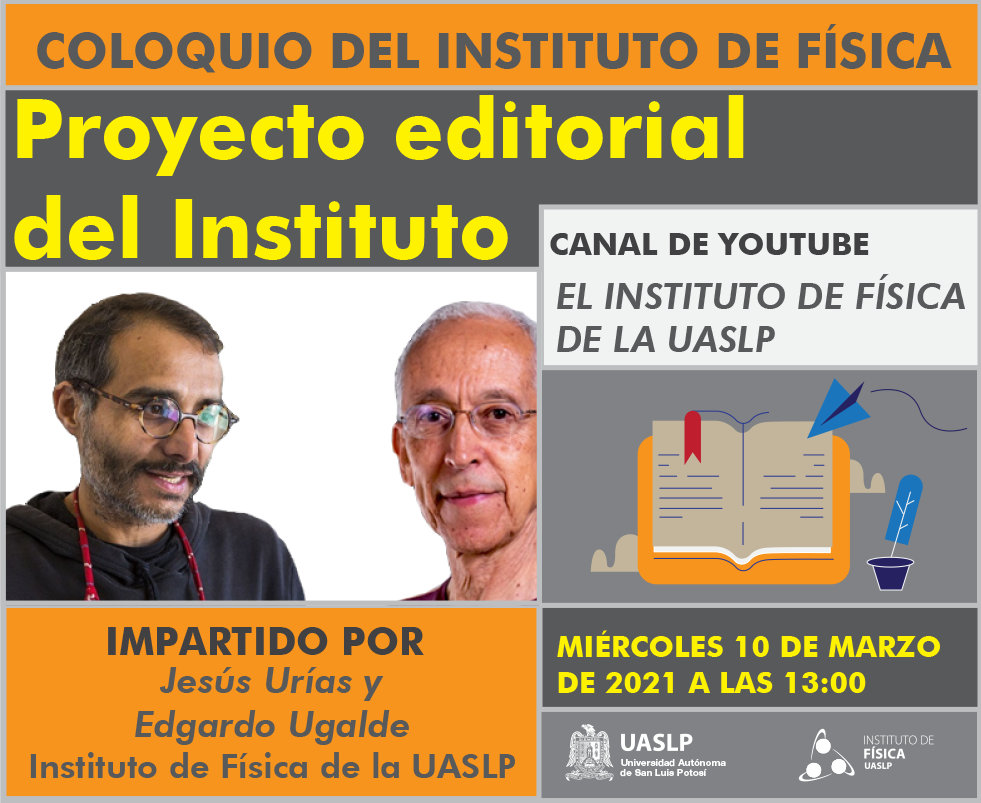
Ponentes: Jesús Urías y Edgardo Ugalde
Resumen:
Desde su fundación, hace ya casi 65 años, los grupos de investigación que integran el Instituto de Física han constituido una fuente de conocimiento científico original y valioso, que por su naturaleza está destinado a ser difundido a través de las revistas especializadas de circulación internacional. Sin embargo, poca difusión hemos dado a nuestro propio saber-hacer y que ---a pesar de su gran diversificación con los años--- le hemos mantenido confinado al interior del Instituto de Física sobreviviendo en cursos, seminarios, escuelas de verano y otras actividades de tal naturaleza. Para poner un remedio a este inconveniente hemos instituido el proyecto de fomentar Ediciones del Instituto de Física que contribuyan a mantener una tradición científica multidisciplinaria que toca temas de física, matemáticas y bioquímica, y compartir nuestra experiencia con investigadores y estudiantes de posgrado de todo el mundo.
Liga de YouTube
https://www.youtube.com/channel/UCijcZAcDo1Ih5u9e8kiFP3g
- Detalles
- Categoría: Coloquio de Física
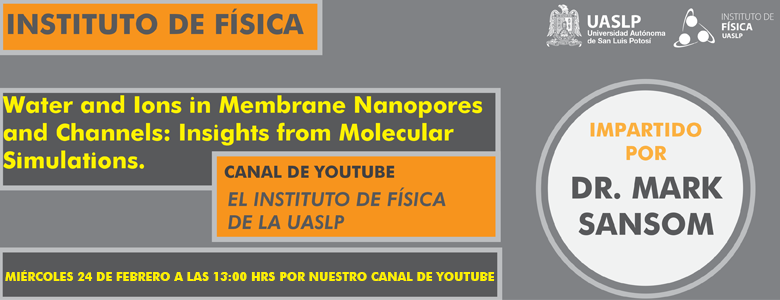
Resumen: Ion channels are proteins which form gated nanopores in biological membranes. Many
channels exhibit hydrophobic gating, whereby functional closure of a pore occurs by local de-
wetting. Molecular dynamics simulations can be used to explore the dynamic behaviour of
water within nanopores and biological channels [1]. Simulation studies of the behaviour of
water in idealised models of nanopores have revealed aspects of the organization and
dynamics of nano-confined water, including wetting/de-wetting in narrow hydrophobic
nanopores. The pentameric ligand gated ion channels (pLGICs) provide a biologically
important example of hydrophobic gating. Molecular simulation studies comparing additive
vs. polarisable models indicate predictions of hydrophobic gating are robust to the model
employed. However, polarisable models suggest favourable interactions of hydrophobic pore-
lining regions with chloride ions, of relevance to both synthetic carriers and to channel
proteins [2]. Electrowetting of a closed pLGIC hydrophobic gate requires too high a voltage
to occur physiologically, but may inform designs of for switchable nanopores [3]. Global
analysis of ~200 channels yields a simple heuristic for structure-based prediction of (closed)
hydrophobic gates. An overall picture emerges whereby the behaviour of water in a nanopore
or channel may be predicted as a function of its hydrophobicity and radius [4][5]. Simulation-
based analysis is shown to provide an aid to interpretation of functional states of new channel
structures.
References
[1] Lynch, C.I., Rao, S., & Sansom, M.S.P. (2020) Water in nanopores and biological
channels: a molecular simulation perspective. Chem. Rev. 120: 10298–10335.
[2] Klesse, G., Rao, S., Tucker, S.J. & Sansom, M.S.P. (2020) Induced polarization in
molecular dynamics simulations of the 5-HT 3 receptor channel. J. Amer. Chem. Soc. 142:
9415-9427
[3] Klesse, G., Rao, S., Tucker, S.J. & Sansom, M.S.P. (2020) Electric field induced wetting
of a hydrophobic gate in a model nanopore based on the 5-HT 3 receptor channel. ACS Nano
14:10480–10491
[4] Rao, S., Klesse, G., Stansfeld, P.J., Tucker, S.J., & Sansom, M.S.P. (2019) A heuristic
derived from analysis of the ion channel structural proteome permits the rapid identification
of hydrophobic gates. PNAS 116: 13989-13995.
[5] Rao, S., Klesse, G., Lynch, C.I., Tucker, S.J. & Sansom, M.S.P. (2021) Molecular
simulations of hydrophobic gating of pentameric ligand gated ion channels: insights into
water and ions. J. Phys. Chem. B. 125: 981–994
- Detalles
- Categoría: Coloquio de Física
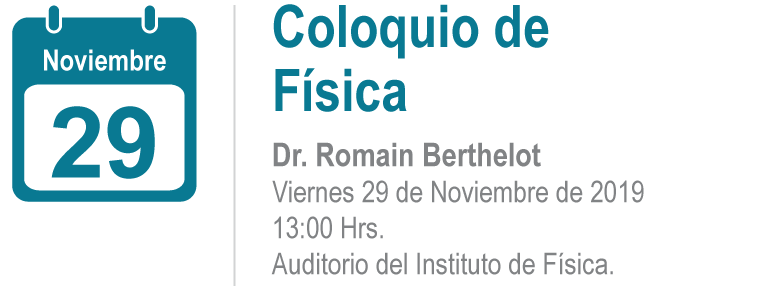
The structure of alkali transition metal layered oxides AMO 2 (with A being an alkali
ions and M a transition metal) is usually describe as a stacking of edge-shared MO 6
octahedra sheets, with alkali ions being intercalated within the interslab spaces. This
particular structure is the key for various physical or chemical properties among, the
most famous properties being the ability to reversibly remove the alkali ions for the
layered structure, giving birth to electrode material for rechargeable batteries.
The family of alkali transition metal oxides gathers a wide range of compositions,
especially because of the chemical tenability of the transition metal slab. Surprisingly,
there is not so much chemical engineering of the alkali layers. Few years at Institut
Charles Gerhardt de Montpellier, we tried to prepare new type of layered oxides with
combination of two alkali elements by solid-state approach. Thanks to a final
quenching at the end of the heat treatment we managed to stabilize new
compositions that are non-thermodynamically stable. In this talk I will present how we
theoretical build such innovative stacking, before showing the physical and chemical
characterizations.
- Detalles
- Categoría: Coloquio de Física
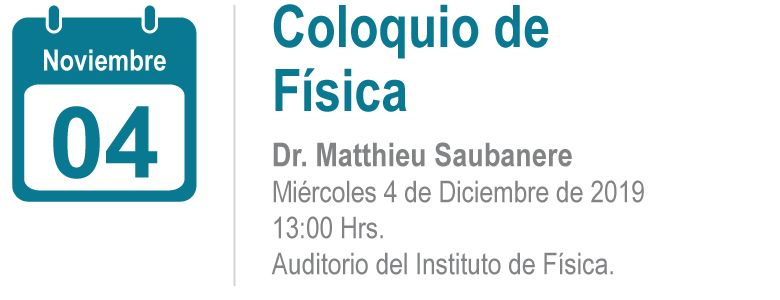
As recently awarded by the Nobel price, Li-ion batteries have revolutionized the
conception of energy storage as being the optimal choice for portable electronic,
electric vehicle and grid applications. Since the first commercialization in 1990,
researchers have focused to improve both storage and aging performances, in
particular on the positive electrode material. In that context, recent improvement of
the material capacity has been shown to rely on oxygen redox in addition the
conventional transition metal redox. While promising such approach is nested by
structural instability and material degradation that limit aging performances. In the
present seminar, we will review challenges that researcher need to address to
improve further the performances electrochemical devices with a particular
attention to the relations between the electronic structure, the redox activity and the
structural integrity of the electrode materials.
- Detalles
- Categoría: Coloquio de Física
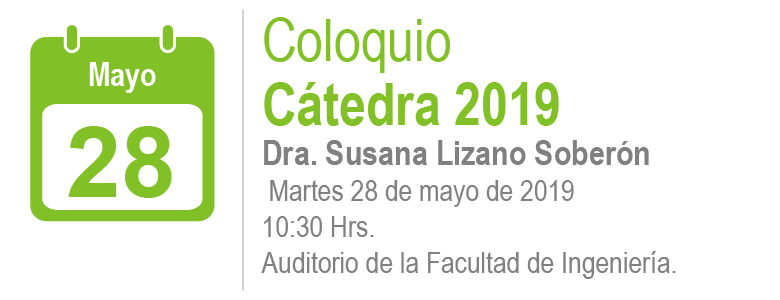
Resumen:
Se hablará del nacimiento de las estrellas en grandes nubes de gas y polvo que se
encuentran en el plano de nuestra galaxia, la Vía Láctea. En estas nubes se forman
núcleos densos que se colapsan por su propia gravedad y forman una estrella o un
grupo de estrellas en su interior. En este proceso la estrella eyecta al espacio un
poderoso viento que se observa por su interacción con la nube materna. También se
forman discos de polvo y gas que rotan alrededor de la estrellas y que darán origen a
sistemas planetarios como nuestro Sistema Solar.
- Detalles
- Categoría: Coloquio de Física
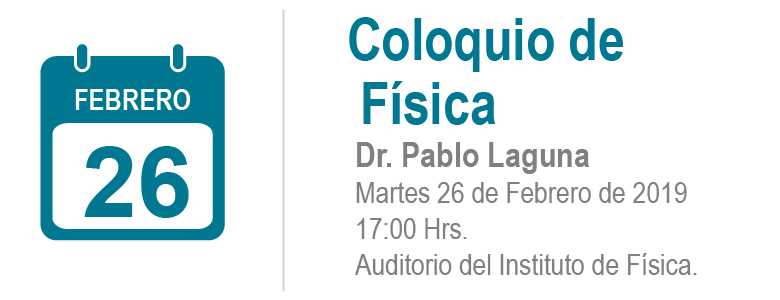
Procedencia: School of Physics - Georgia Institute of Technology
Resumen:
Astronomia de ondas gravitacionales a surgido con la detectacion de ondas gravitacionales emitidas for sistemas binariesde hoyos negros y estrellas de neutrons. Esto ha sido la culminacion de un esfuerzo cientifico y ingenieril extraordinario. En paralelo a este esfuerzo, ls comunicad de la relatividad numerica trabajo tratando de elucidar que tipo de detecccion era de esperarse. En esta charla, presentare un resumen general de las observaciones de ondas graviationales y discutire el papel que las simulaciones numericas jugaron en predecir y caracterizas las fuentes de las ondas.
- Detalles
- Categoría: Coloquio de Física
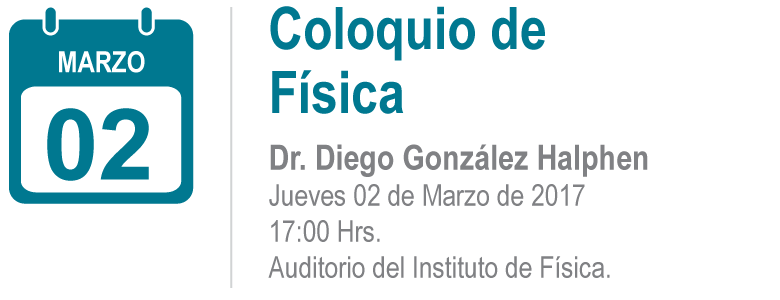
Procedencia: UNAM
Las mitocondrias llevan a cabo diversas funciones metabólicas, entre la que destaca la fosforilación oxidativa. Estos organelos tienen su propio material genético y se han descrito múltiples mutaciones y ablaciones en el ADN mitocondrial humano que dan lugar a diversas patologías. Se piensa que estos organelos se originaron a partir de un evento endosimbiótico que se estableció hace unos 1800 millones de años entre un arqueón (hospedero) y una alfa-proteobacteria (huésped). A lo largo de la evolución, las mitocondrias transfirieron una gran cantidad de genes al núcleo; este fenómeno de migración aún no ha concluido. Lo anterior ha dado lugar a genomas mitocondriales pequeños con un número limitado de genes. Se ha propuesto que en general, los genes que han permanecido en los genomas mitocondriales codifican proteínas de membrana muy hidrofóbicas, con dos o más cruces transmembranales. En la plática abordaremos lo siguiente:
- Generalidades de las mitocondrias
- Origen de las mitocondrias
- Migración de genes y reducción de los genomas mitocondriales
- Ejemplos de reducción extrema
- Cuando hay problemas en los genomas mitocondriales.
- Detalles
- Categoría: Coloquio de Física
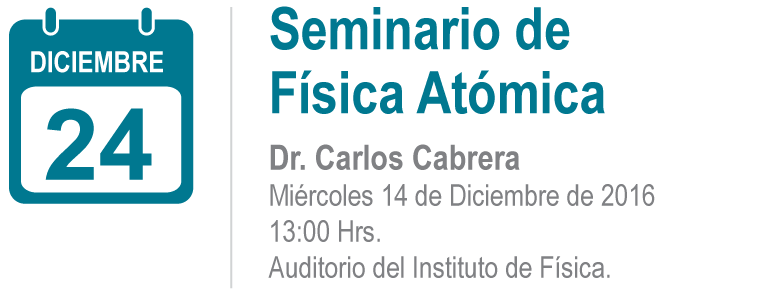
Procedenica: ICFO
Resumen:
In the presence of attractive interactions, a Bose-Bose mixture has been predicted to host a novel type of ultra-dilute liquid-like phase, a quantum droplet [1]. This is a macroscopic self-bound object where the attractive interactions between the particles are exactly compensated by repulsive forces originating purely from quantum fluctuations. Thus, droplets cannot be described in a simple mean-field picture, and their existence is a striking quantum many-body effect. Similar physics has recently been observed in the context of dipolar quantum gases [2-5].
In my talk, I will present the first experimental study of quantum droplets in an attractive spin mixture of two 39K Bose-Einstein condensates. The experiments are performed in an optical wave-guide, where a first order phase transition between a two-component bright soliton and a quantum droplet is expected to take place. We explore the soliton-to-droplet crossover above the critical point and demonstrate the self-bound character of the system, its composite nature, and how quantum fluctuations stabilize the system far beyond the mean-field collapse threshold.
- Detalles
- Categoría: Coloquio de Física

Procedenica: ICFO
Resumen:
In the presence of attractive interactions, a Bose-Bose mixture has been predicted to host a novel type of ultra-dilute liquid-like phase, a quantum droplet [1]. This is a macroscopic self-bound object where the attractive interactions between the particles are exactly compensated by repulsive forces originating purely from quantum fluctuations. Thus, droplets cannot be described in a simple mean-field picture, and their existence is a striking quantum many-body effect. Similar physics has recently been observed in the context of dipolar quantum gases [2-5].
In my talk, I will present the first experimental study of quantum droplets in an attractive spin mixture of two 39K Bose-Einstein condensates. The experiments are performed in an optical wave-guide, where a first order phase transition between a two-component bright soliton and a quantum droplet is expected to take place. We explore the soliton-to-droplet crossover above the critical point and demonstrate the self-bound character of the system, its composite nature, and how quantum fluctuations stabilize the system far beyond the mean-field collapse threshold.
- Detalles
- Categoría: Coloquio de Física
